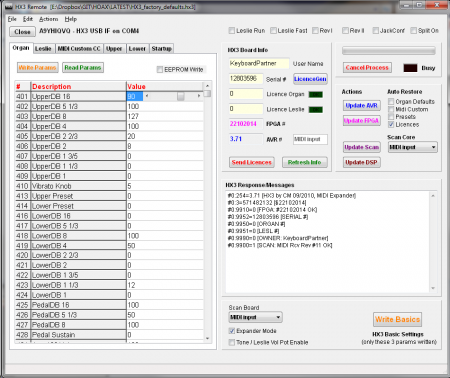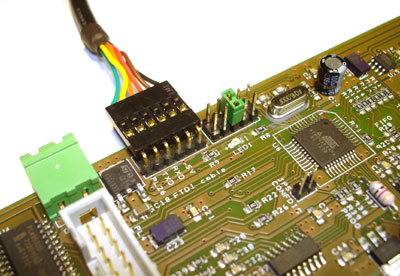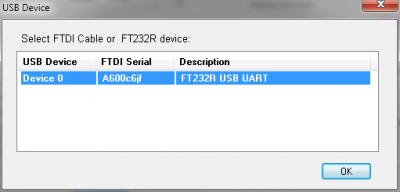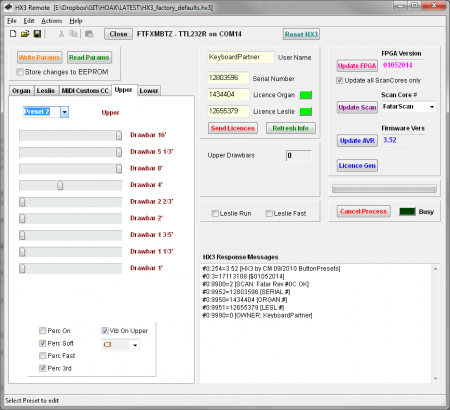HX3 Remote Application
HX3 Remote
HX3 Remote for Windows application (named HX3_remote.exe in Github LATEST directory) is a convenient way to update or maintain your HX3 board or expander. It makes fiddling with previously needed tools TeraTerm and AVRdude completely obsolete. You will need an USB adaptor cable FTDI TTL232R 5V or any USB to serial converter based on FTDI FT232R chipset. Note: USB-Serial adaptors of other makes will not work with HX3 Remote!
Most parameter remote functions require HX3 firmware 3.51 and up (as they rely on the new MenuPanel parameter order), but you may also use it for updating older firmwares and FPGA configurations. New controller firmwares 3.52 and up have a provision to engage the bootloader (see "Updating the AVR Controller Firmware" section below). Before that, you had to reset the HX3 board by a reset jumper to engage the bootloader and to update the firmware - not very user-friendly.
Installation
- Important: Before connecting HX3 Expander with built-in USB Interface to your Windows PC, install driver package from Github /LATEST/DRIVERS directory and, after unzipping, execute installer CDM 2.08.xxx.exe (as admin)!
- Some PCs will need the ftd2xx.dll and libusb0.dll (provided), depending on Windows installation. Do not use FTDI drivers 2.10 or later for HX3 Expander with USB (see above)!
- Create a new folder on your hard disk and copy all files of Github LATEST directory to your folder, for example "E:\LATEST\".
- Unplug your FTDI USB cable from computer again. It is advisable to plug in FTDI cable to HX3 pin header first, then USB plug of cable to computer, then start HX3 Remote. Always quit HX3 Remote before unplugging the FTDI cable.
Connect to HX3 Mainboard
- Be sure that jumpers JP7, JP8 and JP5 are removed as for normal operation.
- Connect header of FTDI USB adaptor cable to your HX3 board as shown in picture. The "+5V" pin of FTDI pin header (leading to red wire of FTDI cable) on older HX3 mk2 boards should be cut off, otherwise USB power will supply the board which may lead to problems as voltage is too weak.
- Power up HX3 board. Plug in FTDI cable to your Windows PC.
- Start HX3_remote.exe by double click. The application is completely self-contained and does not need any installation, but it requires to have the avrdude.exe tool (and maybe the DLLs noted above) in the same folder.
- HX3_remote may complain that HX3_factory_defaults.hx3 could not be found. Click Open to load; it is located in the \LATEST folder. HX3 Remote will remember the file last used.
- Click on Device button. A dialog window appears whichs asks to select the FTDI USB cable from the FTDI devices it found; normally, it should be named "TTL232R", "FT232R USB UART" or similar, and only one is shown. Select it and click OK. Now HX3 should respond to the Console window at bottom and show startup info. All buttons will be enabled if everything is OK.
- Make sure it has assigned a COM Port number other than 0 for AVR update (shown right to Device button); should be in the range 1 to 31.
- Move mouse over some items; the bottom hint line will show help info.
If the console window at bottom shows "-9999" or "Timeout" messages, the connection to HX3 could not be established, maybe due to a corrupted firmware. You may update it anyway, see below. Due to some quirks in the FTDI driver, after Windows Sleep mode it may be necessary to remove and reconnect the FTDI cable from your PC before you start HX3 Remote.
Note: Remove jumpers JP7 and JP8 which may still sit on your board from factory programming. These jumpers are only required for updating the reverb DSP. Also set jumper JP6 to STEREO position (opposite to MONO) as audio routing will be selected by AudioJacks parameter resp. MenuPanel in newer firmware.
Connect to HX3 Expander with USB
- Power up HX3 Expander. Insert a standard mini USB cable to HX3 Expander and plug in to your PC.
- Continue with "Start HX3_remote.exe" as above.
Preface
The HX3 system consists of four parts:
- the AVR controller firmware, which takes care of menus, buttons, pots and drawbars connected to HX3
- the FPGA configuration, the sound engine with tonewheel generator, amps and rotary cabinet simulation
- eight Scan Cores, which scan attached keybeds or MIDI input
- the DSP reverb program for the Spin FV-1 DSP
All parts may be updated independently, although we recommend that you update both AVR and FPGA to maintain integrity. Older FPGA configurations may not work with newer firmware. From HX3 Remote 3.7 and up, all eight Scan Cores are updated with FPGA automatically. There is no need to update the DSP reverb unless the board is for OEM customers or the DSP memory has been replaced.
The AVR controller firmware also contains default settings and presets. Caution: Your own presets will be overwritten if not saved and restored by HX3 Remote Export/Import functions. New HX3 Remote 3.71 has some check boxes to save/restore your settings automatically. In any case, write down your Licence numbers as shown by HX3 Remote's "HX3 Board Info" panel before attempting any update.
Updating the AVR Controller Firmware
All HX3 boards are equipped with a so-called bootloader. The bootloader is a little program that runs for some seconds when you turn the HX3 on or insert and remove the reset jumper. It's main function is to wait for the AVRdude tool (installed along with HX3 Remote) on your computer to send it a new firmware for the HX3, which it then writes to the internal flash memory. This is important, because normally you need a special device (ISP programmer) to program the AVR controller. The bootloader is what enables you to update the HX3 firmware using just the USB cable. This requires the tool AVRdude.exe and its AVRdude.conf file to be present in the same folder as the HX3_remote.exe itself.
- Make sure "Auto Restore Licences" is checked, otherwise you have to re-enter your licence numbers manually.
- Click Update AVR button.
- HX3_remote asks you to select the appropriate .HEX file to program on HX3. Do not use any file with "_boot_" in their names as these are intended for direct ISP programming by OEMs. Versions for mk2 and mk3 version boards are in separate ZIP archives. Please use only the file appropriate for your product. Here is a list of versions available:
- HX3mkX_std.hex Standard version, mainboard with button presets or Preset16
- HX3mkX_expander.hex MIDI expander box version
- HX3mkX_latching.hex Organ with latching presets on Preset12
- HX3mkX_preset24.hex Organ with presets on external Preset24
- HX3mkX_single.hex Compact organ with button presets or Preset16, single manual drawbar assignment
- HX3mkX_single_bv.hex Compact organ with Preset16, single manual drawbar assignment, button vibrato on Panel16
- HX3mk3_xb2.hex HX3 Retrofit Kit for XB2 (mk3 only)
- Every .HEX file is accompanied by a .EEP file with same name which must be present also.
- HX3 Remote sets the HX3 in bootload mode and calls AVRdude with appropriate parameters to flash the new firmware.
- A Windows Command screen appears and runs AVRdude, issuing some nerdy messages.
- When finished (takes a minute or so), HX3 Remote tries to re-sync with HX3 and shows new firmware version info.
As the firmware update overwrites the non-volatile EEPROM parameters, all presets as well as user info and licence numbers, it is time now to re-enter these if you did not check the "Auto Restore (Licence)" box. You may recall them from saved file (see below). This may not work if restoring params from a much older version. After update is completed, please check that you have...
- set the appropriate Scan Core
- enabled/disabled Tone/Amp Volume pots
- set ButtonMask Pins according to your tab layout (buttons or switches)
- green "LEDs" near Licence numbers lit up
Also make sure the FPGA configuration matches to AVR firmware. If not, "FPGA config too old" will be shown in message window.
Updating the FPGA Sound Engine
FPGA configuration and firmware may be updated indepently. Anyway, new FPGA releases may require an update of firmware also and vice versa, as they rely on some features which may not be present in older versions. If in doubt, always update FPGA after every AVR controller update. The FPGA update also installs all Scan Cores. It will not alter your licences, presets and default settings.
- Click on Update FPGA
- A file dialog appears to select the FPGA configuration (a file called fpga_DDMMYYYY.bit with DDMMYYYY as creation date/version).
- Please note that the Scan Cores (files named HX_xxx.DAT) must be present in the same folder as the selected FPGA configuration, otherwise they will be skipped. At least the "HX_MIDI.DAT" should be present for the HX3 Expander.
- Update takes approx. 2 minutes. When done, check the serial number and FPGA version issued.
- If an "Out of Sync" or "Flash verify" error occurred in message window, repeat Update FPGA procedure.
Now you're done! Usually, there is no need to update Scan Cores or DSP reverb program, so disregard the "Update Scan" and "Update DSP" buttons.
Important: HX3 Remote versions below 3.7 do not update the Scan Cores along with FPGA configuration automatically, so they must be installed also. See "Advanced" section for details (bottom of page).
Parameter Tweaking
Editing Organ Parameters
- Select the Organ Defaults tab page.
- Clicking Read Params will update the selected table with parameters read from your HX3.
- You may save the tables and all owner/serial number info to a file by selecting "Save Param File as..." from menu to a different file, so you may create a set of different sounding organs.
- To change a parameter, select it in the table by mouse or arrow keys (click on value). You may either type a new number or use the control in the middle to change. Depending on type of parameter, the control may be a slider (as shown), a drop-down menu or a ON/OFF button.
- All changes are temporarily. To make them permanent (power-on default), check the EEPROM Write box while editing or click Write Params (will take a moment to complete) when finished.
Editing Leslie Parameters
Works as "Editing Organ Parameters" above, but changes defaults for Leslie simulation. These parameters are delicate and improper values may lead to distorted or unwanted results. Use with extreme caution - for experts only.
Editing MIDI Custom CCs
Firmware versions 3.53 and up provide a custom MIDI CC set, selectable by MenuPanel or HX3 Remote's "Organ Defaults". It works like a MIDI learning function, but more convenient by a special translation table. A MIDI CC number received will be translated to a HX3 parameter change with automatic scaling to the parameter range (i.e. a MIDI CC value of 0..127 will be scaled to 0..5 for the vibrato knob setting).
- Select the MIDI Custom CC page.
- You may enter any valid HX3 parameter number (401 to 481 for MenuPanel or Organ Defaults entry, 900 to 907 for upper row of panel buttons, 910 to 917 for lower row of panel buttons). Zero entries will be ignored. Here is the list of button controls (not available through MenuPanel entries):
- 900 Percussion ON
- 901 Percussion SOFT
- 902 Percussion FAST
- 903 Percussion THIRD
- 904 Vibrato Upper ON
- 905 Vibrato Lower ON
- 906 Leslie RUN
- 907 Leslie FAST
- 914 Reverb I ON
- 915 Reverb II ON
- 916 Jack Config B (former Bass on Leslie button)
- 917 Keyboard Split ON
- To make them permanent (power-on default), check the EEPROM Write box while editing or click Write Params (will take a moment to complete) when finished.
A received MIDI CC value (data byte) of >64 (i.e. 127 for digital controllers) switches the button ON, a value of <63 (i.e. 0 for digital controllers) switches the button OFF. The complete list of HX3 parameters can be found in the HX3 mk3 syntax table.
Note: The MIDI Custom CC translation routine in HX3 firmware works for standard MIDI continuous controllers on upper manual channel only. For Doepfer d3C and similar controllers, the NI B4 setting is a better choice. There are some keyboards on the market (Roland, Viscount, Hammond) that use quite weird drawbar encoding schemes. RPN/NRPN parameter changes, SysEx messages as well as special encodings will not work. Use the specialised Hammond CC sets instead if using a Hammond XK or SK series. There are no plans to support the NRPN/SysEx madness.
Editing Presets
- Select the Upper or Lower table tab and the preset you want to edit with the drop-down menu (upper left corner of tab page). Note: "Live 0" is the power-on setting on HX3 without drawbars connected, like HX3 expander module.
- Adjust your preset with sliders and checkboxes at bottom of tab page. All changes are to be heard immediately.
- All changes are temporarily (volatile). To make them permanent (power-on default), check the EEPROM Write box while editing or click Write Params (will take a moment to complete) when finished.
- You may also read the HX3 presets by clicking Read Params before editing. This will read all upper or lower presets, not only the preset shown in the tab page.
- Current presets may be saved to or restored from your personal parameter file also (see "Creating your personal settings file" section below).
Setting User Info and Licences
- Enter your name in the beige User Name field. It should not contain special letters other than ASCII (sorry, Umlaute not allowed).
- If you already have an Organ or Leslie key, they should be displayed in the Licence fields. Invalid keys will be shown, but will not work (indicators right to the licence fields will be dark).
- Old licence numbers from FPGA versions below 01052014 will not work. You may obtain new licence keys from KeyboardPartner as an upgrade (free until June 2014 - send an email with your new serial number after FPGA update regarding "BETA/LATEST").
- If you got new licence numbers, type them in carefully and click Send Licences which will activate the functions if correct and also set the new user name.
- Your personal setting including user name, licences and all parameters should be saved to a personal parameter file (use file menu, "Save Param File as..."). HX3 Remote will remember your personal settings file when starting the application again and open it automatically. Current file path is diplayed in HX3 Remote's window top.
- Update of FPGA, controller firmware and ScanCores work indepently of Licence entries.
Creating your personal settings file
The table to the left shows values found in the param file opened. You may want to read the current values of your HX3 instead:
- Select the table page to be read from HX3 and click Read Params. This will update only the page displayed.
- For each page (Organ Defaults, Leslie Defaults, MIDI Custom CC, Upper and Lower Presets) repeat the steps.
- Click on Refresh Info to read the user name and licence numbers present on your HX3.
- Your personal setting including user name, licences and all parameters should be saved to a personal parameter file (use file menu, "Save Param File as...").
- HX3 Remote will remember your personal settings file when starting the application and open it automatically. Current file path is diplayed in HX3 Remote's window top.
Restoring HX3 with your personal settings file
After updating the AVR controller firmware, the HX3 is set to factory defaults and presets, licence info erased.
- Open your personal parameter file (use file menu, "Open Param File..."). All tables, user name and licence numbers will be read from this file and displayed.
- To restore licence info, click on Send Licences (takes a few seconds).
- To restore one of the tables, select it, check Store changes to EEPROM box and click Write Params. Only the table displayed will be sent, so it is possible to restore the Organ Defaults or the Lower Presets separately, for example.
Advanced
Updating a corrupted or old AVR Controller Firmware
The HX3 bootloader is compatible with Arduino and Atmel STK500v1. On firmware versions 3.52 and up, the bootloader may be invoked by serial command "9980=0" (which is done by HX3 Remote automatically). Firmware versions up to 3.51 had no provision to enter the bootloader without inserting a jumper for hardware reset as described in the wiki page Firmware-_und_FPGA-Update.
- Click Update AVR and select the firmware .HEX file.
- HX3 Remote will show a message to instruct you when to insert and pull the reset jumper (see picture above for location).
- If the AVRdude command window shows an "out of sync" message, you may have removed the reset jumper too late or too early when clicking "OK". Try again.
In rare cases, HX3 may respond to nothing at all, just the bootloader flashes the red LED on board a few times. This might happen if AVRdude is interrupted or cable removed while programming, or a faulty or wrong firmware was installed. Only in this case, download the HX3_avr_repair ZIP file, extract to your local hard disk and follow instructions in README.
Re-Programming by ISP
The bootloader is protected against accidental overwriting by special fuses. Anyway, the complete AVR controller may be re-programmed by an external ISP programmer for AVR chips. In github repo FOR_OEM you will find a sample batch for reporgramming HX3 with the DIAMEX PROG-S ISP programmer from Reichelt. This installs standard firmware 3.71 and also re-installs bootloader if damaged.
Updating a corrupted FPGA Sound Engine
The FPGA and ScanCores could not be updated as described before if the FPGA configuration on HX3 is corrupted (will show "0000000" or "FFFFFFFF" as FPGA version, also indicated by flash verify errors in message window, yellow LED on HX3 board stays off). HX3 will fall into a test mode in this case, indicated by blinking panel button LEDs and a message on MenuPanel (if present). HX3 Remote will regard this case and tell you when to insert and remove the CONF_DIS jumper. When inserted, it prevents the FPGA from blocking the flash programming.
- Only in this case you must insert the CONF_DIS jumper on your HX3 board as requested by HX3 Remote.
- Make sure HX3 responds to "Refresh Info" button. It may show random or invalid serial FPGA Version numbers. If there is no response ("-9999" timeout message), click Reset HX3 button and try again. In rare cases, it may be necessary to quit HX3 Remote, unplug the FTDI cable, power-off HX3 and start all over.
- Click Update FPGA. A file dialog will appear to select the FPGA configuration (normally "main_midi.bit"). Please note that the Scan Cores (files named "HX_xxx.DAT") must be present in the same folder as the selected FPGA configuration, otherwise they will be skipped. At least the "HX_MIDI.DAT" should be present for the HX3 Expander.
- After update (will take about 2 min.), remove the CONF_DIS jumper and click Reset HX3.
- When done, check the serial number and FPGA version issued.
Updating all ScanCores
ScanCores are routines for a small embedded processor in the FPGA which drive the attached scan boards or accept MIDI input. Note: ScanCores could only be updated if the FPGA configuration is OK (check Serial# and FPGA Version).
- Select Update ALL in drop-down menu near Update Scan button.
- Click on Update Scan. A file dialog will appear to select one of the ScanCores (like "HX_XXX.DAT") - this is just to define the folder where the ScanCores are located. Please note that the ScanCores to be updated must be present in the same folder as the selected one, otherwise they will be skipped. At least the "HX_MIDI.DAT" should be present for the HX3 Expander.
Updating a single ScanCore
- Select the ScanCore to be updated by drop-down menu ScanCore #.
- Click on Update Scan.
- A file dialog will appear to select one of the ScanCores (like "HX_XXX.DAT"). Normally, it should match the one you selected in the drop-down menu ScanCore #, i.e. if you selected "FatarScan" you should open the HX_FATAR.DAT ScanCore file. However, it is possible to overwrite a ScanCore # with a different one (for experts only!).
Making Your Own HX3 Remote
HX3 Remote is written in Object Pascal (Delphi Release 2005). You might be a better Delphi programmer than me, so feel free to improve the application (and tell others!). Sources are provided in our Github repo (fork it to your own release). Suggestions for improvements are welcome.



